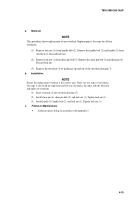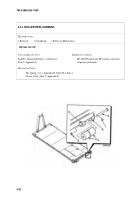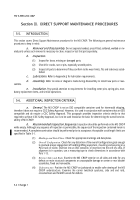TM-9-3990-260-14-P - Page 120 of 306
TM 9-3990-260-14&P
5-2
Change 1
Section III.
DIRECT SUPPORT MAINTENANCE PROCEDURES
This section covers Direct Support Maintenance procedures for the M3 CROP. The following are general maintenance
procedures to keep in mind:
a.
Removal and Disassembly.
Do not separate bonded, press-fitted, soldered, welded or riv-
eted parts unless such removal is necessary to clean, inspect or test that part separately.
b.
Inspection.
(1)
Inspect for loose, missing or damaged parts.
(2)
Check for cracks, rust or pits, especially at weld points.
(3)
Inspect all parts to determine if they conform to the wear limits, fits and tolerances estab-
lished.
c.
Lubrication.
Refer to Appendix J for lubrication requirements.
d.
Assembly.
Refer to notes or diagrams made during disassembly to install new parts or reas-
semble.
e.
Installation.
Pay special attention to requirements for installing cotter pins, spring pins, man-
datory replacement items, and similar operations.
a.
General.
The M3 CROP is not an ISO compatible container used for intermodal shipping,
therefore it does not require a CSC Safety Approval. However, it is used in conjunction with containers that are ISO
compatible and do require a CSC Safety Approval. This paragraph provides inspection criteria similar to that
required to achieve CSC Safety Approval, but is to be used instead as the basis for determining the overall service-
ability of M3 CROP.
b.
Recommended Inspection Sequence.
Inspection should be performed on the M3 CROP
while empty. Although any sequence of inspection is permissible, the sequence of the inspection contained herein is
recommended. A complete examination should be performed prior to acceptance. Acceptable crack length limits are
specified in Table 5-1.
(1)
Markings and Data Plates.
Check for appropriate markings and data plates.
(2)
Overall Configuration.
Check for any distortion of the overall configuration great enough
to preclude proper engagement of handling/lifting equipment, mounting and securing on a
PLS truck or trailer, insertion into an ISO container, or insertion into the cell of a ship. If
alignment is in question, use a measuring tape to check dimensions in accordance with
Para 1-13.
(3)
Exterior Sides and Ends.
Examine the M3 CROP exterior on all sides and ends for any
defects on main structural components or unacceptable damage on center or rear blocker
assemblies, fixed and removable.
(4)
Understructure.
Position the M3 CROP on jackstands to enable safe viewing of the M3
CROP understructure. Examine the corner twistlock apertures, side and end rails,
crossmembers and forklift tunnels for defects.
5-5.
INTRODUCTION.
5-6.
ADDITIONAL INSPECTION CRITERIA.
Back to Top




















